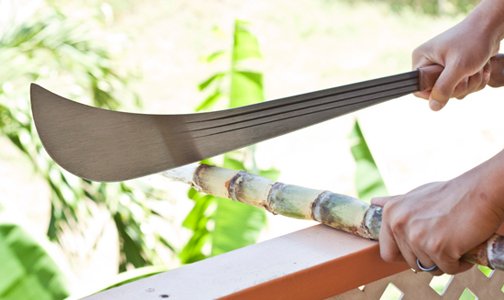What is a Machete?
A machete is a broad-bladed tool that serves both as a knife and an axe, commonly used for agricultural, survival, and outdoor purposes. It features a long, flat blade, typically ranging from 12 to 26 inches (30 to 66 cm) in length, and is used for cutting, chopping, and clearing vegetation.
Origins and Etymology
The word “machete” originates from the Spanish term “macho,” meaning hammer or sledgehammer. Some historians trace its roots back to “machaera,” the name given by Greeks and Romans to a curved sword known as the falcata. While the term “machete” is widely used, in some English-speaking Caribbean nations, such as Jamaica and Trinidad and Tobago, it is often referred to as a “cutlass.”
Common Uses of Machetes
Machetes have been a crucial tool across various cultures and industries due to their versatility. Some of their primary uses include:
1. Agriculture and Gardening
- Harvesting crops such as sugarcane, rice, and corn
- Clearing brush and overgrown vegetation
- Pruning trees and removing invasive plants
2. Outdoor and Survival Applications
- Clearing trails for hiking and hunting
- Cutting wood for firewood and shelter construction
- Fending off dangerous animals or venomous snakes
- Crafting tools, poles, and spears in survival situations
3. Household and Domestic Uses
- Splitting coconuts and other hard-shelled fruits
- Butchering livestock and processing meat
- Chopping compost materials for quicker decomposition
4. Tactical and Combat History
Historically, machetes have been used in uprisings and warfare. Notable instances include:
- Cuban independence wars, where revolutionaries used machetes as weapons
- The Rwandan genocide, where machetes were infamously used
- The Haitian Tonton Macoute militia, known for carrying machetes
Types of Machetes
Machetes come in various designs, each suited for specific tasks:
- Latin Machete: The traditional style with a straight blade, ideal for general-purpose use
- Kukri Machete: Originating from Nepal, it has a curved blade for powerful chopping
- Bolo Machete: Popular in the Philippines, featuring a thick blade used for agricultural tasks
- Panga Machete: Common in Africa, with a weighted blade for cutting thick vegetation
Manufacturing and Materials
High-quality machetes are crafted from durable materials, such as carbon steel or stainless steel, for longevity and sharpness retention. The handle can be made from wood, plastic, or composite materials for a comfortable grip.
Cultural Significance
Machetes hold cultural importance in many regions:
- The flag of Angola features a machete symbolizing agricultural labor and revolution
- Brazilian folk dances, such as dança dos facões, incorporate machetes in performances
- Filipino martial arts, like Eskrima, use the bolo machete in training and combat
Conclusion
The machete remains an indispensable tool worldwide, blending functionality with cultural heritage. Whether used in farming, outdoor survival, or historical warfare, its versatility ensures its relevance across generations.

